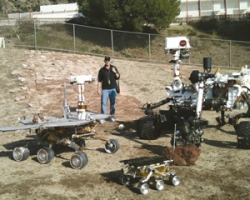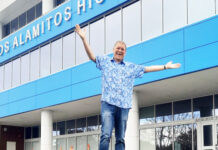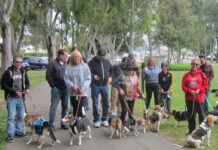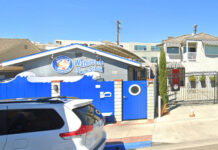Jim Wright drives Curiosity, the latest Martian rover. He and his wife live here for the windsurfing
By Charles M. Kelly
John Wright lives in Seal Beach, works in Pasadena and drives on Mars.
He was driving on Mars just this past weekend.
Fortunately, he can telecommute from here to Mars.
Wright works at the Jet Propulsion Laboratory that now explores space. Originally, JPL was in the business of building rockets.
The space-exploration facility is located in Pasadena.
Wright drives the latest Mars rover, Curiosity, and has worked on the Sojourner Truth and Spirit/Opportunity missions.
He has worked at JPL for 18 years.
He and his wife have lived in Seal Beach for 16 years.
He said the commute to Pasadena was “horrible,” especially with all the freeway construction currently going on.
“I like living in Seal Beach,” he said.
“Plus, my sport is windsurfing,” Wright said. “So if I lived in Pasadena, I’d have to drive down here.”
Wright said he and his wife moved to Seal Beach for the windsurfing.
“I evaluated the choice of commuting from Seal Beach to Pasadena for work or commuting from Pasadena to Seal Beach for windsurfing and decided that we would probably just stay home too often if we lived in Pasadena—so here we are,” Wright said.
“Once we got here, we found out the weather is a lot nicer than elsewhere as well. We save money and protect the environment by not needing air conditioning,” he said.
“We live in a great neighborhood and know all our neighbors, love walking down Main Street and out to the pier, and the Christmas Parade is the best around,” he said.
His official title is “rover planner.” Wright said a joke at JPL speculates that the job was given a dull title so few people would apply for it.
Wright is one of 16 planners working on the Curiosity project.
He said about half of those planners (including Wright) worked on the Spirit/Opportunity project.
The two rovers, Spirit and Opportunity, were supposed to explore Mars for 90 days. Spirit stopped communicating with Earth in 2010. Opportunity is still working.
Meanwhile, Wright has gone on to work on a mission that is planned to last for one Martian year—almost two Earth years.
Ultimate telecommute
While there’s no traffic on Mars, driving a rover on the red planet has certain challenges.
For one thing: the one-ton Curiosity rover is a long way from here.
The minimum distance between the two planets is about 34 million miles.
The maximum: not quite 140 million.
Wright said it took the one-ton Curiosity rover about eight-and-a-half months to make the trip.
By contrast, the previous rovers—Spirit, Opportunity and Sojourner Truth—took about seven months.
Wright didn’t know the exact distance between the two planets at this time.
“That’s one of those numbers I don’t need to know,” he said.
Curiosity landed on Mars on Monday, Aug. 6.
Wright said that at the time of the landing, Mars was 10 “light minutes” from Earth—meaning it would take a signal 10 minutes to travel from Earth to Mars. Which also means it would take a signal 10 minutes (or longer now) to travel back to Earth.
“So you cannot drive it (a rover) in real time,” Wright said.
He uses a two- screen and three-dimensional computer display to “drive” the rover.
The display combines 3-D renderings of the planet with a model of the rover to show where it is and where it is supposed to go.
Wright said JPL sends commands to the rover early in the morning and hear from it at the end of the day.
“So if something goes wrong and we drive it off a cliff, basically we never hear from it again,” Wright said.
Working rover
Curiosity mostly works during the daytime, when it is warm. To give you an idea: an 84 degree day in Seal Beach would be considered hot. On Mars, 20 degrees below zero is considered warm.
Night time is too cold for the rover, when temperatures can drop as much as 100 degrees below zero.
Curiosity travels at a “speed” of 2.5 meters (yards) per minute. As of Sept. 20, Curiosity has moved 290 meters from the landing site.
There are three “modes” for driving a rover. In blind mode, Wright or another planner sends the rover commands to move so far and turn so much.
Blind mode is the fastest mode for the rover, so planners like Wright usually use the “blind” setting to drive Curiosity.
Automatic or hazard mode allows the rover’s on-board computer to decide to avoid a potential collision.
The third method, visual odometry, is more complex. The rover is currently driving on fairly flat ground as it makes its way to a mountain named Sharpe. When a rover reaches a slope, JPL scientists photograph the ground before and after each move and then calculate how much slippage has occurred.
As for Mt. Sharpe, it looks remarkably like one of the geological features of the Grand Canyon. The NASA website used similar words to described the layers of Mt. Sharpe. “We don’t know for sure what created those layers,” Wright said.
Curiosity is moving toward Mt. Sharpe to see what created the layers in the rock.
Wright, who is not a geologist, said there are three ways nature creates layers: dust, water and volcanic eruption. Curiosity is going to have to reach that mountain to investigate the source of those layers.
“If we knew what was there, we wouldn’t be sending them (the rovers),” he said.












